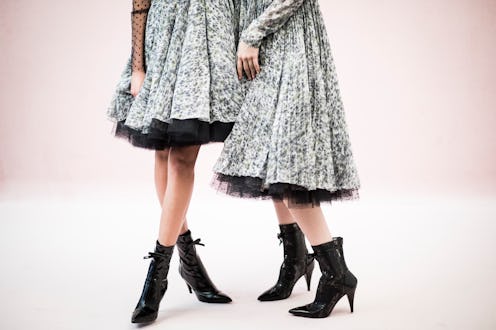
Have you ever looked at those women who manage to wear stiletto heels morning, noon, and night and wonder, "How the eff does she do that?" Besides investing in a full-time car service and daily foot massages (which have always been my personal conspiracy theories) they've cracked the code and managed to figure out how to take care of feet in high heels.
So what’s their secret? "Unfortunately, most high heel construction is so unhealthy and unstable, that even walking can be dangerous!" says podiatrist and shoe designer Joan Oloff. "[But] I know women who can rock my highest heels from morning until late evening. They prepare their bodies, just like athletes do!" In doing this, they acclimate their bodies to the unnatural act teetering around on stilettos and making it look effortless. (I think I may have just found my new favorite sport, if anyone is interested in joining my training squad.)
Oloff recently launched her own line of functional, comfortable shoes to try and change the mindset that high heels are meant to be “sitting shoes,” and prove that beauty does not have to mean “pain”… at least when it comes to high heels. Here are her tips for how to take care of your feet when wearing heels so you can conquer the world in whatever shoes you damn well please.
1. Understand The Potential Damage
High heels don't just hurt your feet when you take them off at the end of a long day — they can have some pretty gnarly long term effects, too, so it's important to watch out for any signs of permanent damage. The first thing most women notice is pressure and pain on the ball of their foot because traditional heels put too much pressure on these bones, as well as the joint where the metatarsal bones meet the toes. "Short term, this causes pain, while long term it can lead to bone spurs and arthritis," says Oloff. "Because most heels provide an unstable situation, the tendons going into the toes overwork. They both ache from fatigue and cause hammertoes and corns long term."
2. Work To Strengthen Your Feet
Just when you thought you'd finally mastered your gym routine, it turns out that you need to add in "foot exercises" after your arms/abs/ass class. "I know women who can rock my highest heels from morning until late evening," says Oloff. "These women also spend time developing strength and flexibility." Stronger feet mean less potential for long term damage, and will make wearing heels all day long at least mildly more bearable.
3. Use Your Legs
Heels don't just mess with your feet — they can have some pretty pain-inducing effects on your back and legs, too. Oloff suggests stretching the achilles tendon and muscles in the back of the leg to avoid the shortening that heels cause. "Strengthening the muscles helps to keep the body in alignment and avoid secondary knee and back problems," she says.
4. Choose The Right Shoes
At the end of the day, no matter how hard you try to train your feet, the problem may be the shoes, not you. "On a basic level, the structure of the foot and the construction of the shoe are not in sync," says Oloff. "Most high fashion shoe designers care very little about the foot. There is too much pressure on the ball of the foot. All of the bones, joints, and nerves in the ball of the foot are overloaded and breakdown." Oloff's line features a "pentagon heel," meant for women who aren't quite ready for full-blown stilettos. Her shoes provide more ankle stability and provides a unique platform under the ball of the foot, which offloads the pressure points in ways never done before in heels.
5. Don't Shy Away From Treatment
It's normal for high heels to hurt, but only to a certain point. "If you are experiencing pain after wearing a particularly painful pair of heels, change footwear, rest, and ice," says Oloff. "If, after a few days, there is still pain, I would recommend seeing a podiatrist. Early intervention may be helpful in preventing problems from becoming chronic."